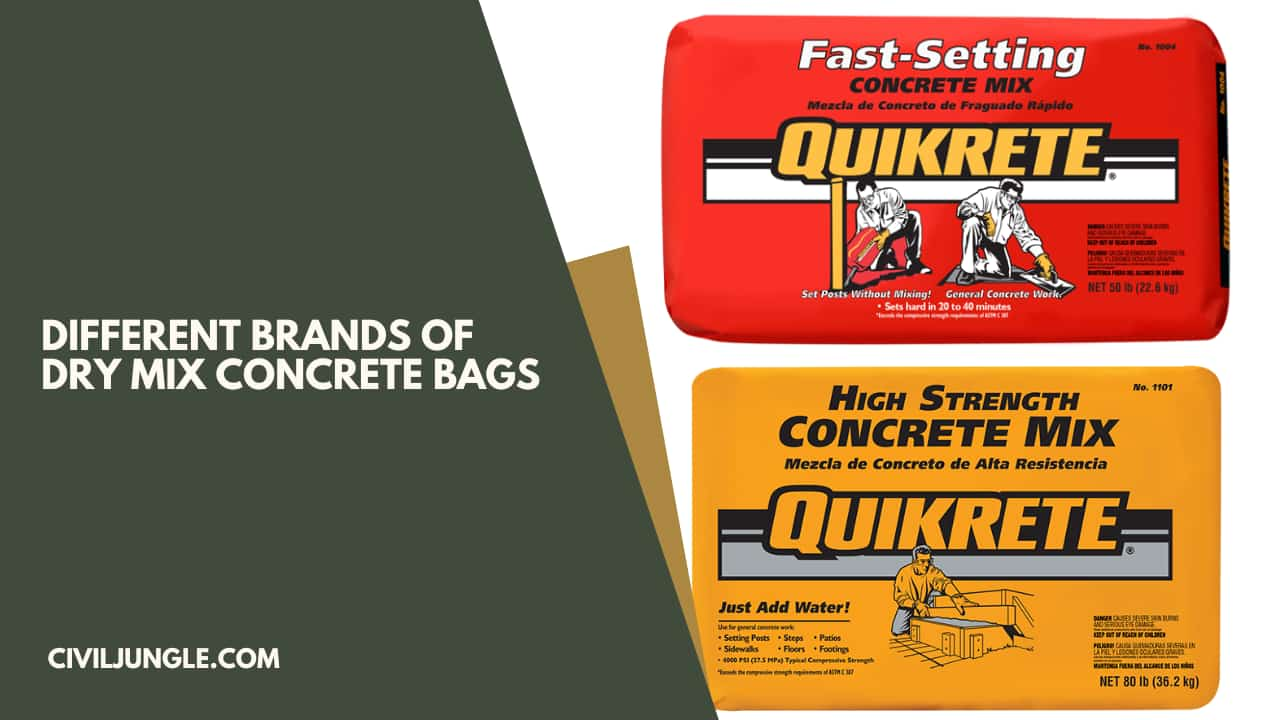How Many Bags of Concrete Do I Need?
Important Point
Bags of concrete is required according to the requirement of the concrete. Bags of concrete depends on the size of the structure, if the concrete requirement is more then we need more bags of concrete and if the concrete requirement is less then we need less amount of concrete bags.
In the example of for 10’ x 10’ x 5” slab is below
Method – 1
- The weight of concrete= [(10 x 10 x (5)/12] x 133.34 = 5556 pound= 2520 kg
- If the weight of concrete is 40 kg, the number of bags required= (2520/40) = 63 nos.
- If the weight of concrete is 40 lb, the number of bags required= (2520/18.14) = 140 nos. (1 lb = 0.45 kg)
Method – 2
Step-1: Calculate Volume of Concrete Required Pouring 10 X 10 Slab Thickness 4 inch
The calculation of volume of slab is the multiplying of length, width, and thickness.
Example:
Let’s consider 10′ x 10′ slab with thickness 4”
- Length= 10 feet
- Width= 10 feet
- Thickness= 4”
- Volume of concrete= L x B x T
- Volume of concrete = 10 x 10 x (0.33)
- Volume of concrete = 33.00 cu. Ft……….(Because 12” = 1 feet, 4/12 = 0.33 feet)
- It is equal to 0.23 cu. Meter or 0.3 cubic yard.
Explanation:
- 3 ft= 1 yard, 3ft x 3 ft x 3ft = 1 yard x 1 yard x 1 yard
- 27 cubic feet = 1 cubic yard
- After that, we divide 33 cubic feet by 27 to get the volume of concrete in the cubic yard.
- Volume of concrete = 33/27 = 1.22 cubic yard
Step-2: Adding 10% of Extra Volume
- Now we are adding 10% of extra volume because of dry volume and wastage of concrete.
- 1.23 x 10% = 1.23 x (10/100) = 0.122 cubic yard
- So, the total volume of concrete = Original Volume + Extra Volume = 1.23 + 0.122 = 1.35 cubic yard
Step-3: Find Out How Many Bags of Concrete Do I Need
- To find the bags required to pour the slab, we need to divide the volume of concrete by yield of concrete bags.
- Bags are generally available in different sizes like 40lb, 45lb, 60lb, 80lb, and 90lb.
Different bag sizes and their yield values are given in the chart-
| Sizes of bag |
Yield |
| 40 lb (18.1 kg) | 0.3 cubic feet (0.008 cubic meter) |
| 45 lb (20.4 kg) | 0.34 cubic feet (0.01 cubic meter) |
| 60 lb (27.2 kg) | 0.45 cubic feet (0.012 cubic meter) |
| 80 lb (36.2 kg) | 0.6 cubic feet (0.016 cubic meter) |
| 90 lb (40.8 kg) | 0.68 cubic feet (0.02 cubic meter) |
- From the upper table, we are using a 40 lb bag and the yield value is 0.011 cubic yards.
- So, number of bags are calculated by dividing total volume of concrete with yield vale of bags.
- So, 1.35/0.011 = 122 bags
- So, for 10 x 10 slab with a thickness of 4”, we need 122 bags of concrete.
Also, read: What Is Unit Weight | What Is Density | What Is Unit Weight Material | Unit Weight Building Materials
Useful Article For You
- What Is a Contour Interval
- What Is Tile
- What Is the Difference Between a Shower Pan and a Shower Base?
- What Is a Window Panel
- Type of Arch
- What Is the Measurement for a Queen Size Bed
- What Is Considered Livable Space
- What Is One Way You Can Save Electricity?
- What Is a Bundle of Shingles
- What Is a Gallon of Water Weigh
- What Is Sand Blasting
- What Is a Span Bridge
- What Is the Little Black Diamond on a Tape Measure
- What Is a Louvered Door
- What Is a Spread Footing
- What Is Leveling
- Different Types of Beam
- What Is Pedestal
- What Is Plumbing Fixtures
- Soft Floors
- What Is Slab Construction
- What Is Calacatta Quartz
- What Is Auxiliary View
- Sheepsfoot Roller
- What Is 1 Flight of Stairs
- What Is Refractory Cement
- Dry Pack Concrete
- What Is Luminous Flux Vs Lumens
- What Is a Frost Wall
- What Is an Undercoat
- What Is Road Pavement
- Arch Foundation
- What Is a Stair Landing
- What Is a Spandrel Beam
- What Is Pier and Beam Foundation
- What Is a Pile Cap
- What Is a Mat Foundation
- What Is a Floating Slab
- What Is the Purpose of Foundation
- What Is a Flush Door
- What Is Residential Construction
- What Is the Best Foundation for a House
- What Is a Benchmark in Surveying
- What Is a Engineering Drawing
- What Is an Admixture
- What Is the Standard Size Water Supply Line
- What Is the Difference Between Tension and Compression?
- What Is a Tremie
- What Is Tributary Area
- What Is Shoring Construction
- What Is a Cason
- What Is Wall Putty
- What Is the Difference Between Mortar and Concrete
- What Is Bhk
- What Is Sbc of Soil
- What Is Plinth Level
- What Is Water Proofing
- What Is Mix Design of Concrete
- What Is Fine Aggregate
- What Is Retention Money
- What Is Design Mix
- What Is Isometric Scale
- What Is Development Length
- What Is Superelevation
- What Is Wall Made Of
- What Is Micro Piling
- What Is Soil Stack
- What Is a Half Wall Called
- What Is Flagstone
- What Is a Cinder Block
- What Is Floors
- What Is a Parapet in Construction
- What Is Concept Drawing
- What Is a 30 Degree Angle
- What Is a Mezzanine Level
- What Is Plinth Area
- What Is Precipitation
- What Is a Soffit
- What Is the Difference Between Residual and Transported Soil
- What Is a Drop Manhole
- What Is Oblique View
- What Is a Flyover Bridge
- What Is Tie Beam
- What Is the Cost of 1 Bag Cement
- What Is Well Foundation
- What Is the Principle of Chain Surveying
- What Is Dlc in Road Construction
- What Are the Advantages of Levelling
- What Is Hardened Concrete
- What Is Plinth Protection
- What Is Wbm Road
- What Is Measurement Book
- What Is Traversing in Surveying
- What Is the Space Between Windows Called
- What Is a Moment Frame
- What Is 53 Grade Cement
- What Is True Slump
- What Is Joisted Masonry Construction
- What Is the Back Azimuth of 180 Degrees
- What Is Stretcher Bond
- What Is Consistency of Cement
- What Is Pointing
- What Is Design Period
- What Is Long Column and Short Column
- What Is the Full Form of Rcc
- What Is Centering in Construction
- What Is Stone Masonry
Different Brands of Dry Mix Concrete Bags
Different brands of dry mix concrete bags are-
- Ultra Tech Cement
- ACC Limited
- Nuvoco
- RDC Concrete
- Build Supply
- Shaila
How Many Bags of Concrete Do I Need for Slab with 4” Thickness?
Method – 1
- The weight of dry concrete is 3600 pounds per cubic yard.
- So, the weight of dry concrete per cubic foot = 3600/ = 133.34 pounds
- [as we know, 1 yard = 3 feet]
Let’s Assume,
- Length of slab = 5 feet
- Width of slab = 5 feet
- S0, the weight of dry concrete = [{Length (in foot) x Width (in foot) x Thickness (in inches) / 12} x 133.34] = Weight (in pounds)
In this Case,
- [(5 x 5 x 4) / 12] x 133.34 = 1111.16 pounds = 504 kg
- The weight of one of dry cement concrete is 40 kg
- So, the number of bags are required = 504/40 = 12.6 nos.
Method – 2
Step-1: Calculate Volume of Concrete Required Pouring 5 X 5 Slab Thickness 4 inch
The calculation of volume of slab is the multiplying of length, width, and thickness.
Example:
Let’s consider 5×5 slab with thickness 4”
- Length= 5 feet
- Width= 5 feet
- Thickness= 4”
- Volume of concrete= L x B x T
- Volume of concrete = 5 x 5 x (0.33)
- Volume of concrete = 8.25 cu. Ft. …………(Because 12” = 1 feet, 4/12 = 0.33 feet)
- It is equal to 0.23 cu. Meter or 0.3 cubic yard.
Explanation:
- 3 ft= 1 yard, 3ft x 3 ft x 3ft = 1 yard x 1 yard x 1 yard
- 27 cubic feet = 1 cubic yard
- After that we divide 8.25 cubic feet by 27 to get the volume of concrete in cubic yard.
- Volume of concrete = 8.25/27 = 0.3 cubic yard
Step-2: Adding 10% of Extra Volume
- Now we are adding 10% of extra volume because of dry volume and wastage of concrete.
- 0.3 x 10% = 0.3 x (10/100) = 0.03 cubic yard
- So, the total volume of concrete = Original volume + Extra volume = 0.3 + 0.03 = 0.33 cubic yard
Step-3: Find Out How Many Bags of Concrete Do I Need
- To find the bags required to pour the slab, we need to divide the volume of concrete by yield of concrete bags.
- Bags are generally available in different sizes like 40lb, 45lb, 60lb, 80lb and 90lb.
Different bag sizes and their yield values are given in the chart-
|
Sizes of bag |
Yield |
| 40 lb (18.1 kg) |
0.3 cubic feet (0.008 cubic meter) |
| 45 lb (20.4 kg) |
0.34 cubic feet (0.01 cubic meter) |
| 60 lb (27.2 kg) |
0.45 cubic feet (0.012 cubic meter) |
| 80 lb (36.2 kg) |
0.6 cubic feet (0.016 cubic meter) |
| 90 lb (40.8 kg) |
0.68 cubic feet (0.02 cubic meter) |
- From the upper table, we are using 40 lb bag and the yield value is 0.011 cubic yard.
- So, number of bags are calculated by dividing total volume of concrete with yield vale of bags.
- So, 0.33/0.011 = 30 bags
- So, for 5 x 5 slab with a thickness of 4”, we need 30 bags of concrete.
How Many Bags of Concrete Do I Need for Slab with 5” Thickness?
Method – 1
Let’s assume,
- Length of slab = 5 feet
- Width of slab = 5 feet
- Previously we determined that the weight of dry concrete per cubic foot is 133.34 pounds.
- S0, the weight of dry concrete = [{Length (in foot) x Width (in foot) x Thickness (in inches) / 12} x 133.34] = Weight (in pounds)
In this case,
- [(5 x 5 x 5) / 12] x 133.34 = 1389 pound = 630 kg
- The weight of one of dry cement concrete is 40 kg
- So, the number of bags are required = 630/40 = 16 nos.
Method – 2
Step-1: Calculate Volume of Concrete Required Pouring 5 X 5 Slab Thickness 5 inch
The calculation of volume of slab is the multiplying of length, width and thickness.
Example:
- Let’s consider 5×5 slab with thickness 5”
- Length= 5 feet
- Width= 5 feet
- Thickness= 5”
- Volume of concrete= L x B x T
- Volume of concrete = 5 x 5 x (0.42)
- Volume of concrete = 10.5 cu. Ft………..(Because 12” = 1 feet, 5/12 = 0.42 feet)
- It is equal to 0.39 cubic yard.
Explanation:
- 3 ft= 1 yard, 3ft x 3 ft x 3ft = 1 yard x 1 yard x 1 yard
- 27 cubic feet = 1 cubic yard
- After that we divide 10.5 cubic feet by 27 to get the volume of concrete in cubic yard.
- Volume of concrete = 10.5/27 = 0.39 cubic yard
Step-2: Adding 10% of Extra Colume
- Now we are adding 10% of extra volume because of dry volume and wastage of concrete.
- 0.39 x 10% = 0.39 x (10/100) = 0.04 cubic yard
- So, the total volume of concrete = Original volume + Extra volume = 0.3 + 0.04 = 0.34 cubic yard
Step-3: Find Out How Many Bags of Concrete Do I Need
- To find the bags required to pour the slab, we need to divide the volume of concrete by yield of concrete bags.
- Bags are generally available in different sizes like 40lb, 45lb, 60lb, 80lb, and 90lb.
Different bag sizes and their yield values are given in the chart-
|
Sizes of bag |
Yield |
| 40 lb (18.1 kg) |
0.3 cubic feet (0.008 cubic meter) |
| 45 lb (20.4 kg) |
0.34 cubic feet (0.01 cubic meter) |
| 60 lb (27.2 kg) |
0.45 cubic feet (0.012 cubic meter) |
| 80 lb (36.2 kg) |
0.6 cubic feet (0.016 cubic meter) |
| 90 lb (40.8 kg) |
0.68 cubic feet (0.02 cubic meter) |
- From the upper table, we are using 40 lb bag and the yield value is 0.011 cubic yard.
- So, a number of bags are calculated by dividing total volume of concrete with yield vale of bags.
- So, 0.34/0.011 = 30.9 bags = 31 bags
- So, for 5 x 5 slab with a thickness of 5”, we need 31 bags of concrete.
How Many Bags of Concrete Do I Need for Slab with 6” Thickness?
Method – 1
Let’s assume,
- Length of slab = 5 feet
- Width of slab = 5 feet
- Previously we determined that the weight of dry concrete per cubic foot is 133.34 pounds.
- S0, the weight of dry concrete = [{Length (in foot) x Width (in foot) x Thickness (in inches) / 12} x 133.34] = Weight (in pounds)
In this case,
- [(5 x 5 x 6) / 12] x 133.34 = 1666.75 pounds = 756 kg
- The weight of one of dry cement concrete is 40 kg
- So, the number of bags are required = 756/40 = 19 nos.
Method – 2
Step-1: Calculate Volume of Concrete Required Pouring 5 X 5 Slab Thickness 6 inch
The calculation of volume of slab is the multiplying of length, width and thickness.
Example:
- Let’s consider 5 x 5 slab with thickness 6”
- Length= 5 feet
- Width= 5 feet
- Thickness= 6”
- Volume of concrete= L x B x T
- Volume of concrete = 5 x 5 x (0.5)
- Volume of concrete = 12.5 cu. Ft…………(Because 12” = 1 feet, 6/12 = 0.5 feet)
- It is equal to 0.46 cubic yard.
Explanation:
- 3 ft= 1 yard, 3ft x 3 ft x 3ft = 1 yard x 1 yard x 1 yard
- 27 cubic feet = 1 cubic yard
- After that, we divide 12.5 cubic feet by 27 to get the volume of concrete in cubic yard.
- Volume of concrete = 12.5/27 = 0.46 cubic yard
Step-2: Adding 10% of Extra Volume
- Now we are adding 10% of extra volume because of dry volume and wastage of concrete.
- 0.46 x 10% = 0.46 x (10/100) = 0.05 cubic yard
- So, the total volume of concrete = Original volume + Extra volume = 0.3 + 0.05 = 0.35 cubic yard
Step-3: Find Out How Many Bags of Concrete Do I Need
- To find the bags required to pour the slab, we need to divide the volume of concrete by yield of concrete bags.
- Bags are generally available in different sizes like 40lb, 45lb, 60lb, 80lb, and 90lb.
Different bag sizes and their yield values are given in the chart-
|
Sizes of bag |
Yield |
| 40 lb (18.1 kg) |
0.3 cubic feet (0.008 cubic meter) |
| 45 lb (20.4 kg) |
0.34 cubic feet (0.01 cubic meter) |
| 60 lb (27.2 kg) |
0.45 cubic feet (0.012 cubic meter) |
| 80 lb (36.2 kg) |
0.6 cubic feet (0.016 cubic meter) |
| 90 lb (40.8 kg) |
0.68 cubic feet (0.02 cubic meter) |
- From the upper table, we are using 40 lb bag and the yield value is 0.011 cubic yard.
- So, a number of bags are calculated by dividing total volume of concrete with yield vale of bags.
- So, 0.35/0.011 = 31.8 bags = 32 bags
- So, for 5 x 5 slabs with a thickness of 6”, we need 32 bags of concrete.
Useful Article for You
- Zero Force Members
- How Much Does a Yard of Concrete Weigh
- Cmu Wall Meaning
- Gradient Road
- Budget Sunroom Ideas
- What Is Gypsum Board
- Types of Vaulted Ceilings
- How Does Baking Soda Remove Blood from Carpet
- What Are Forms in Construction
- How Heavy Is Dirt
- Tender Meaning in Architecture
- Dark Olive Green House
- Cast in Place Concrete
- Lean to Roof
- How Tall Is an Average Door
- Grade Beam Foundation
- Window Sill Height
- Concrete Cold Joint
- Types of Traps
- Types of Pipe
- Wood Supporting Beams
- Finishing Plaster
- Home Depot Scrap Wood
- Lvl Beam Size Calculator
- Structural Shell
- Curb Types
- Msand
- Optimum Dry Meaning
- Disadvantages of Low-E Glass
- Bridge Abutment Definition
- Build Materials List
- Composite Masonry Wall
- Is Cedar a Hardwood or Softwood
- Modified Proctor Test
- Physical Properties of Sand
- Crane Machine Construction
- Types of Gable Roofs
- Door Frame Types
- How Much Does 55 Gallons of Oil Weigh
- Dog Leg Stairs
- Concrete Salt Finish
- Westpoint Bridge Builders
- Types of Porches
- Hempcrete Disadvantages
- Roof Pitch Types
- Types of Weirs
- Asphalt Floor
- Dutch Roof
- #6 Rebar Weight Per Foot
- Prizmatic Compass
- Bond Break Concrete
- Poured Concrete Wall Cost Calculator
- How Many 60 Lb Bags of Concrete in a Yard
- Wood Fence Post Spacing Chart
- Falsework
- Design of Building Structures
- Topping Slab
- Types of Cinder Blocks
- Fresh Concrete
- Door Colors for Red Brick House
- Clear Cover Concrete
- Tiles Brand
- Cement Consumption in Plaster
- Aggregate Density Kg M3
- Weight of Concrete Slab Calculator
- Is Clay Smaller Than Silt
- How to Calculate Dead Load
- Bad Concrete Work
- Stepped Foundations
- Residential Construction Cost Estimator Excel
- Different Construction Trucks
- Septic Pump Replacement Cost
- Dead Load Calculator
- Beam Vs Column
- Concrete Mix Ratio
- Caisson Foundation
- Glulam Beam Weight Calculator
- Bituminous Pavement
- M30 Mix Ratio
- Is 2502
- Reinforced Brick Work
- Plinth Level
- Trapezoidal Footing Formula
- Slab Steel Calculation
- Rolling Margin of Steel
- Top 20 Pvc Pipe Brands in India
- Top 5 Cement in India
- How Much Weight Can a 6×6 Support Horizontally
- Modulus of Rupture Formula
- Types of Curtains
- Building Estimate Excel Sheet
- How Is the Skeleton Similar to the Frame of a House?
- Which of the Following Best Explains Why Buildings Tip During Earthquakes?
- Rate Analysis of Civil Works
- Water Tank Company Name
- 1 Soot in Mm
- Reinforcement Lap Length Table
- Camber in Road
- Rate Analysis of Plaster
- Ply Company Name
- Boq Full Form in Tender
How Many Bags of Concrete Do I Need for Slab with 8” Thickness?
Method – 1
Let’s assume,
- length of slab = 5 feet
- width of slab = 5 feet
- Previously we determined that the weight of dry concrete per cubic foot is 133.34 pounds.
- S0, the weight of dry concrete = [{Length (in foot) x Width (in foot) x Thickness (in inches) / 12} x 133.34] = Weight (in pounds)
In this case,
- [(5 x 5 x 8) / 12] x 133.34 = 2223 pound = 1008.34 kg
- The weight of one of dry cement concrete is 40 kg
- So, the number of bags are required = 1008.34/40 = 25 nos.
Method – 2
Step-1: Calculate Volume of Concrete Required Pouring 5 X 5 Slab Thickness 7 inch
The calculation of volume of slab is the multiplying of length, width and thickness.
Example:
- Let’s consider 5×5 slab with thickness 8”
- Length= 5 feet
- Width= 5 feet
- Thickness= 8”
- Volume of concrete= L x B x T
- Volume of concrete = 5 x 5 x (0.67)
- Volume of concrete = 16.75 cu. Ft…………… (Because 12” = 1 feet, 8/12 = 0.67 feet)
- It is equal to 0.62 cubic yard.
- Explanation:
- 3 ft= 1 yard, 3ft x 3 ft x 3ft = 1 yard x 1 yard x 1 yard
- 27 cubic feet = 1 cubic yard
- After that we divide 16.75 cubic feet by 27 to get the volume of concrete in cubic yard.
- Volume of concrete = 16.75/27 = 0.62 cubic yard
Step-2: Adding 10% of Extra Volume
- Now we are adding 10% of extra volume because of dry volume and wastage of concrete.
- 0.62 x 10% = 0.62 x (10/100) = 0.062 cubic yard
- So, the total volume of concrete = Original volume + Extra volume = 0.3 + 0.062 = 0.362 cubic yard
Step-3: Find Out How Many Bags of Concrete Do I Need
- To find the bags required to pour the slab, we need to divide the volume of concrete by yield of concrete bags.
- Bags are generally available in different sizes like 40lb, 45lb, 60lb, 80lb, and 90lb.
Different bag sizes and their yield values are given in the chart-
| Sizes of bag |
Yield |
| 40 lb (18.1 kg) |
0.3 cubic feet (0.008 cubic meter) |
| 45 lb (20.4 kg) |
0.34 cubic feet (0.01 cubic meter) |
| 60 lb (27.2 kg) |
0.45 cubic feet (0.012 cubic meter) |
| 80 lb (36.2 kg) |
0.6 cubic feet (0.016 cubic meter) |
| 90 lb (40.8 kg) |
0.68 cubic feet (0.02 cubic meter) |
- From the upper table, we are using a 40 lb bag and the yield value is 0.011 cubic yards.
- So, a number of bags are calculated by dividing total volume of concrete with yield vale of bags.
- So, 0.362/0.011 = 32.9 bags = 33 bags
- So, for 5 x 5 slab with a thickness of 8”, we need 33 bags of concrete.
How Many Bags of Quikrete Do I Need?
There are different numbers of bags are required a certain square feet design. The number of bags depends on the weight of those bags.
So, first, let’s assume the dimension of the required area is (5 x 5)= 25 square feet.
Quikrete bags required for-
Different weights for a 5 ‘x 5’ x 4 “slab size in a hair bag are as follows.
Weight of one bag |
40 lb. | 50 lb. | 60 lb. | 80 lb. |
No. Of bags required |
28 | 23 | 19 | 14 |
Different weights for a 5 ‘x 5’ x 5″slab size in a hair bag are as follows.
Weight of one bag |
40 lb. | 50 lb. | 60 lb. | 80 lb. |
No. Of bags required |
35 | 28.5 | 23.5 | 17.5 |
Different weights for a 5 ‘x 5’ x 6″slab size in a hair bag are as follows.
Weight of one bag |
40 lb. | 50 lb. | 60 lb. | 80 lb. |
No. Of bags required |
42 | 34 | 28 | 21 |
Different weights for a 5 ‘x 5’ x 8″slab size in a hair bag are as follows.
Weight of one bag |
40 lb. | 50 lb. | 60 lb. | 80 lb. |
No. Of bags required |
56 | 45 | 37 | 28 |
How Much Concrete Do I Need?
- According to the requirements of concrete, the bags will be decided.
- If the structure is large then it requires more bags of concrete and if the structure is small compared to the large structure then it required less number of bags.
- The example of how many bags of concrete do I need for a 10’ x 10’ x 5” slab is below-
- The weight of concrete= [(10 x 10 x 5)/12] x 133.34 = 5556 pound
- We know the density of dry mix concrete is 133 lb
- So, the volume is (5556/133) = 41.78 = 1.18
- So, we need to order 1.18 dry concrete.
Bags of Concrete
Boral makes no guarantee of the accuracy or completeness of the information and recommends you conduct your own testing to determine suitability for your specific purpose. One 20kg bag will cover an area of 1.1m2 to a depth of approximately 10mm. Or 108 x 20kg bags equates to one cubic meter of mixed concrete.
Quikrete Super Sacks
One 50-pound bag of quikrete fast-setting concrete mix yields about. 375 cubic feet. For example, if you need to cover 33.333 cubic feet, using 60-pound bags of concrete, divide 33.333 cubic feet by. 45 cubic feet to get 74.07 total bags of concrete.
Mixed Cement Bags
General description: “acc baguette” is a carefully proportioned blend of high-quality raw materials including well-graded fine & coarse aggregates, ordinary portland cement, and special concrete admixtures. Uses individual houses, gardens, small concrete repair works, small structures – foundations, columns, slabs, etc.
Lightweight Concrete Bag Mix
Using less sand can make the product lighter, but it can also make the concrete weaker structurally. A simple recipe for basic lightweight concrete is to combine 8 parts sand, 8 parts cement and 8 parts perlite to 5 parts water.
Concrete Mix Ready to Use
Ready-mix concrete tends to be better for many projects, in spite of its higher cost. Ready-mix concrete offers a higher quality, and variation between batches is minimal when concrete is prepared in a plant environment.
Quikrete Rip Rap
Rip rap is a loose stone used as a foundation for a breakwater. It is also used as a form of erosion control and can be seen on large embankments, shorelines, creeks, rivers and around discharge pipes. Dense broken concrete, stone blocks and other durable material shaped into cubic form make up SCC’s product.
80 lb Quikrete Concrete Mix
15 cubic feet for every 20 pounds of a mix, so a 40-pound bag yields. 30 cubic feet, 60 pounds of concrete mix yields . 45 cubic feet and an 80-pound bag yields. 60 cubic feet.
Concrete Grout Bags
You can use a mixture of cement, sand, and water within a grout bag to repair the brick structure. The grout bag works like a pastry bag to apply a controlled layer of cement mixture.
Small Bag Concrete Mix
The recommended water amount for each eighty-pound bag of concrete mix will require about three quarts of water for approximately two-thirds of the water into the depression.
Like this post? Share it with your friends!
Suggested Read –
- What Is Kelly Ball Test | Test Procedure of Kelly Ball Test | Use of the Kelly Ball | Advantages of Kelly Ball Test | Disadvantages of Kelly Ball Test
- 9 Types of Curing | What Is Curing of Concrete | Why Curing Is Important | Minimum Curing Period for Concrete Cement | How Long Does It Take for Concrete to Dry
- What Is Dressing of Stone | Types of Dressing of Stone
- Floating Slab Vs Monolithic Slab | What Is Monolithic Slab | What Is Floating Slab
- Alignment of Road | Alignment In Design | Horizontal Alignment of Road | Vertical Alignment of Road
- What Is Auxiliary Plane | Types of Auxiliary Plane | Types of Auxiliary View | How to Draw Auxiliary View | Drawing Steps for Auxiliary View
- Well Point System | Types of Well Point System | Well Point Dewatering | PVC Well Point | Well Point Installation | Well Point for Shallow Well
- What Is a Cavity Wall | How to Build a Cavity Wall | Cavity Wall Detail | Cavity Wall Thickness | Cavity Wall Insulation Pros and Cons | Brick Cavity Wall





Leave a Reply